AgCollector
Harmless

Posts: 24
Registered: 31-7-2018
Member Is Offline
|
|
Electrorefining of Tin
I've been working on purifying tin from pewter and lead-free solder and wanted to share my set up and results: following operating parameters in the
range of those suggested by the authors of this paper
Materials Science and Engineering, Volume 37/2. (2012), pp. 19–26
and their other papers I set up an electrolyte with 1 M HCl and 20 g/L Sn in the form of SnCl2, hooked up a power supply with a limit of
0.2 V, and made a stainless steel cathode. While it takes quite a bit of time to build up any amount of tin (the current is pretty low), on the other
hand the tin winds up over 99.9% pure (had a friend with work access to XRF check it out) and the dendritic crystals are really neat looking (see
images).
Just wanted to share with some folks who'll appreciate it!
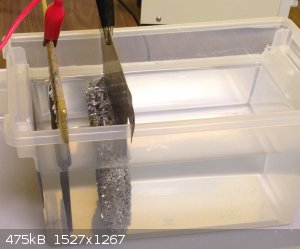 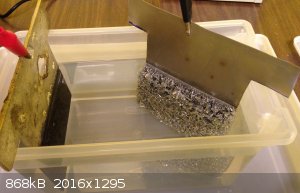 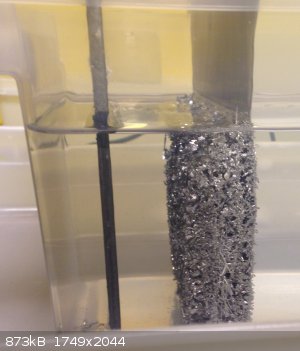 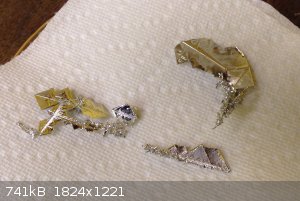
|
|
|
Ubya
International Hazard
    
Posts: 1247
Registered: 23-11-2017
Location: Rome-Italy
Member Is Offline
Mood: I'm a maddo scientisto!!!
|
|
those are some cool looking metal crystals. if i have the patience to purify some lead-tin alloy i have, i'm definitely going to try this out
---------------------------------------------------------------------
feel free to correct my grammar, or any mistakes i make
---------------------------------------------------------------------
|
|
|
Herr Haber
International Hazard
    
Posts: 1236
Registered: 29-1-2016
Member Is Offline
Mood: No Mood
|
|
Neat looking indeed: I first though your electrode was a metallic foam !
|
|
|
RedDwarf
Hazard to Others
  
Posts: 166
Registered: 16-2-2019
Location: UK (North West)
Member Is Offline
Mood: Variable
|
|
I s the tin on the cathode coming from the anode (in which case was this pewter, and what was happening to the anode during electrolysis) or was this
just the tin chloride already in solution forming the crystals?
|
|
|
AgCollector
Harmless

Posts: 24
Registered: 31-7-2018
Member Is Offline
|
|
Quote: Originally posted by RedDwarf  | | I s the tin on the cathode coming from the anode (in which case was this pewter, and what was happening to the anode during electrolysis) or was this
just the tin chloride already in solution forming the crystals? |
The general idea is that the tin already in solution gets reduced on the cathode while simultaneously tin from the anode undergoes oxidation and
dissolves into solution, ideally maintaining a constant concentration of tin in solution.
The anode appears black but if you try to scrape it a lot of black gunk (anode slime) will come off - basically, unoxidized remainders from the anode.
This particular anode started as a pewter plate that was 94% tin, 5% antimony, and 1% copper. I find that the anode slime typically still contains
50-65% tin as well as the antimony and copper.
|
|
|
Sulaiman
International Hazard
    
Posts: 3692
Registered: 8-2-2015
Location: 3rd rock from the sun
Member Is Offline
|
|
It is good that you operated at low current density because when I was playing with similar https://www.youtube.com/watch?v=G1sq4hnrBgM&t=11s
I found that higher currents cause longer dendrites,
also, long thinner-than-hair threads reach out to the anode then on contact vapourise due to the power supply current.
[Edited on 13-3-2019 by Sulaiman]
CAUTION : Hobby Chemist, not Professional or even Amateur
|
|
|
Fulmen
International Hazard
    
Posts: 1716
Registered: 24-9-2005
Member Is Offline
Mood: Bored
|
|
Is it pure enough to convert to β-tin?
We're not banging rocks together here. We know how to put a man back together.
|
|
|
Ubya
International Hazard
    
Posts: 1247
Registered: 23-11-2017
Location: Rome-Italy
Member Is Offline
Mood: I'm a maddo scientisto!!!
|
|
99.9% pure. sure it can convert to β-tin
---------------------------------------------------------------------
feel free to correct my grammar, or any mistakes i make
---------------------------------------------------------------------
|
|
|
AgCollector
Harmless

Posts: 24
Registered: 31-7-2018
Member Is Offline
|
|
It's currently β, but as you say, pure enough that I worry about its spontaneous conversion to α and take care to store it out of my unheated
basement!
At some point I am planning on seeing how long it can stay β at a temp slightly below the conversion temperature. I'm sure throwing it in the
freezer would do the trick but I wonder how long it can stay unconverted at, say, 10 or 12 °C?
|
|
|
Fulmen
International Hazard
    
Posts: 1716
Registered: 24-9-2005
Member Is Offline
Mood: Bored
|
|
My bad, I was of course thinking of α-tin. Would be fun to see how fast it can convert as well, say within "normal cold winter temperatures".
We're not banging rocks together here. We know how to put a man back together.
|
|
|
AgCollector
Harmless

Posts: 24
Registered: 31-7-2018
Member Is Offline
|
|
Nice video! Yep, my current density's quite low (nominally ~60 A/m2 on the cathode not considering the massive increase in surface area
due to deposited tin); I was going for quantity rather than speed but one would die of boredom watching my reaction (pictures are after 4 days'
reaction time).
|
|
|
DraconicAcid
International Hazard
    
Posts: 4332
Registered: 1-2-2013
Location: The tiniest college campus ever....
Member Is Offline
Mood: Semi-victorious.
|
|
If you were to run the electroysis at near freezing-temperatures, would the tin form as the other allotrope?
Please remember: "Filtrate" is not a verb.
Write up your lab reports the way your instructor wants them, not the way your ex-instructor wants them.
|
|
|
AgCollector
Harmless

Posts: 24
Registered: 31-7-2018
Member Is Offline
|
|
Now that's an interesting thought! The cathode's crystal structure may preferentially form one over the other, and I don't think the α form is
conductive (so it might coat a cathode and then passivate it?) but on the other hand if it did work it'd be a neat way to avoid the growth of long tin
dendritic crystals that short out the cell:
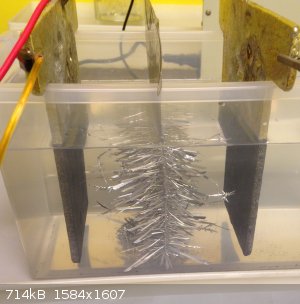 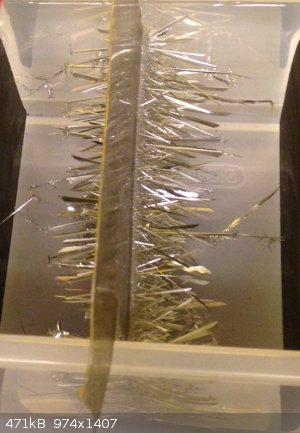
|
|
|
DraconicAcid
International Hazard
    
Posts: 4332
Registered: 1-2-2013
Location: The tiniest college campus ever....
Member Is Offline
Mood: Semi-victorious.
|
|
Is it completely non-conductive, or just not as conductive as the metallic form?
Please remember: "Filtrate" is not a verb.
Write up your lab reports the way your instructor wants them, not the way your ex-instructor wants them.
|
|
|
AgCollector
Harmless

Posts: 24
Registered: 31-7-2018
Member Is Offline
|
|
Well, though Wikipedia describes it as having "no metallic properties" on the other hand the abstract of this 1954 paper
https://journals.aps.org/pr/abstract/10.1103/PhysRev.97.607
gives the conductivity at 0 °C as 2.09 x 105 S/m which seems to be comparable to graphite (though a factor of 100 less than most metals).
Sounds like, it would actually be conductive enough for an electrochemical process.
|
|
|
Sulaiman
International Hazard
    
Posts: 3692
Registered: 8-2-2015
Location: 3rd rock from the sun
Member Is Offline
|
|
I believe but have not verified that periodically briefly reversing the polarity applied to the cell reduces dendritic growth.
When playing with a small tin electrolysis cell I noticed that reversing the polarity causes tin to migrate from the dendrites, (as expected)
the thinnest dendrites appear to 'suffer' the most,
so the short (1 second or so ... t.b.d.) reverse pulses remove long thin dendrites and 'blunten' the shorter fatter ones.
I remember long ago reading about reverse polarity pulses being used for electrolytic plating,
and even during wet Ni-Cd battery charging (I think ... memory fading)
probably based on a similar principle ?
You could try manualy reversing the polarity periodically, (e.g. 1 second of reversal per minute ?)
or use something like a 555 timer and a 2-pole changeover relay.
-----------------------
I also believe that long dendrites form because the metal concentraion in the electrolyte is depleted in the volume near the cathode occupied by the
mass of dendrites,
this leaves more concentrated higher conductivity electrolyte between the tips of the dendrites and the anode.
Also, the voltage gradient is greater between the dendrite tips and anode as the tips of the dendrites are nearer to the anode.
I guess that vigorous stirring would help to significantly reduce dendritic growth mechanisms.
[Edited on 17-3-2019 by Sulaiman]
CAUTION : Hobby Chemist, not Professional or even Amateur
|
|
|